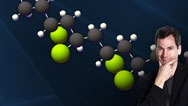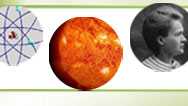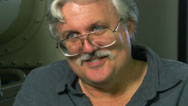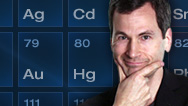Island of Stability
- Posted 09.03.06
- NOVA scienceNOW
(This video is no longer available for streaming.) Chemical elements are the fundamental building blocks of nature, and while most of them—carbon, copper, iron, neon, etc.—were born within stars, scientists like nuclear chemist Ken Moody are struggling to create new ones in the lab. According to a theory pioneered by Moody's mentor, Nobel laureate Glenn Seaborg, if researchers can somehow manage to pack just the right number of protons and neutrons into a nucleus, they will reach what Seaborg called the "island of stability." Their new elements should be remarkably stable and could have extraordinary properties. Travel with NOVA scienceNOW inside the nucleus of an atom to learn how protons and neutrons interact and how even the tiniest constituents of nature can be manipulated.
Transcript
ISLAND OF STABILITY
PBS Airdate: October 3, 2006
NEIL DEGRASSE TYSON: Okay, remember this thing? That mysterious chart of boxes from chemistry class? Of course; it's the periodic table. It lists all the known elements, like hydrogen, gold, calcium, aluminum and even, down here, Einsteinium.
What makes an element unique is the number of protons each atom contains. We call that its atomic number.
The table starts up here, at one, and keeps going and going and going. But way down here, it just stops. What's up with that? Why can't we just add more protons to an atom and build new elements?
Well, correspondent Carla Wohl has found some folks who spent their lives trying to do just that.
CARLA WOHL: Every atom in the universe was born in fire: oxygen, iron, neon, copper, carbon, the fundamental building blocks that make up all matter, all things, were created with immense heat and pressure, by the big bang, stars, or sometimes by scientists like Ken Moody.
KEN MOODY: I don't feel very stellar, I guess.
CARLA WOHL: He does, however, rise before the sun each morning and gets to work by 5:00, seven days a week.
KEN MOODY: That's the way it is.
CARLA WOHL: He's a nuclear chemist whose passion is filling in the blanks at the upper reaches of the periodic table.
Pop quiz: the chart of elements, Number 44?
KEN MOODY: Uh, Ruthenium.
CARLA WOHL: Ooh, very good. 109?
KEN MOODY: Meitnerium.
CARLA WOHL: Very good. 114?
KEN MOODY: Unnamed, at this point; you're not going to trick me.
CARLA WOHL: The trick, as Ken sees it, is to be the one to name 114, which he's been on a quest to discover for more than two decades.
KEN MOODY: We tend to call these things discovery experiments, but we're really producing them. It's a...it's an act of creation.
CARLA WOHL: Creating them with atomic colliders, quantum calculation and something passed on to him by his mentor, Dr. Glenn Seaborg.
KEN MOODY: He was a big believer in those little 35 millimeter slides, and he'd take a graduate student to run the projector for him.
CARLA WOHL: One of those students was none other than Ken Moody. That's a younger Ken, there. For 30 years, Ken has held on to this particular slide: Seaborg's map, a mythical place the elements of the periodic table inhabit. And it's here where our story begins.
KEN MOODY: Where uranium and thorium dwell, the end of the nuclei that exist in nature...
CARLA WOHL: Number 92, uranium, is the last of the naturally occurring elements. This is as far as the stars got. But Glen Seaborg thought he could pick up where the stars left off, actually creating elements. And he did, marching up the periodic table, creating elements 94, 95, 96, 97, 98, 101 and 102. He won a Nobel Prize for his pioneering work, and created more elements than any human ever had. And then he could go no further.
DAVID KAISER (Massachusetts Institute of Technology): Even Seaborg ran out. You know, the process by which he was making these—he and his whole large team by this point—that way of trying to add in more protons to a nucleus, that route finally dried up.
CARLA WOHL: David Kaiser teaches the history of science at MIT.
DAVID KAISER: What Seaborg had been able to do—and many colleagues by this point—was sort of go step by step, add in one new nucleus at a time, by just going, literally, baby steps.
CARLA WOHL: How exactly do you take baby steps? Let's start at the beginning. We'll take a trip and fly into an atom, past the electrons, into the nucleus. In a science where you never see what you're working with, a lot is left to the imagination. So first, let's meet some protons, for our purposes, represented by these guys.
KEN MOODY: ...all positively charged. And we all remember from science class in high school that two positive charges repel one another.
CARLA WOHL: With this repulsion, how do any of the elements stay together?
DAVID KAISER: The protons feel a different sort of force, as well, at the same time. It's a different origin, a different type of force between them. And that's a specifically nuclear force. It's called the strong force.
CARLA WOHL: We'll show this as a bungee cord.
DAVID KAISER: And that really is how this force behaves. If they try to pull apart, it will pull them back together. It's an attractive, coming together, sort of force. But, like a bungee cord, it only works over a certain distance. If you try to stretch it too far, that cord will break.
KEN MOODY: That repulsive force wins.
CARLA WOHL: And that's where this guy comes in.
NEUTRON ANIMATION: Hello.
CARLA WOHL: He is a neutron.
KEN MOODY: I went to school with an awful lot of neutrons.
This is a fellow who comes equipped with bungee cords, like the proton.
CARLA WOHL: But unlike the proton, he has no charge, no inclination to push anything away. He just sort of sits there, neutrally; his bungee cord does the work. So, throw him in between a pair of struggling protons, hook up his bungee to...
KEN MOODY: The neutron provides some remediation of the hostility of the protons, and they can survive.
CARLA WOHL: Up to a point. By the time he got to element 102, with 102 protons in the nucleus, Seaborg began having problems.
DAVID KAISER: Even if you add in more bungees, they might keep this cluster together here, they might keep that cluster together there. But keeping the whole big thing together, that no longer is going to work. The pushing-away force starts to win.
CARLA WOHL: And there was another problem. Seaborg found, the more protons he added, the shorter the atom survived, from billions of years down to thousands, days, hours, minutes.
DAVID KAISER: Even much less, sometimes thousandths of a second, if you're lucky. Often, it's millionths of a second. So these things will fall apart, literally, in less than a blink of an eye.
CARLA WOHL: Seaborg came to see himself surrounded by a cruel and inhospitable ocean that tore his atoms apart. He called it a "sea of instability."
DAVID KAISER: This sea, that they didn't know if they could cross or not, that's what was inspiring and really teasing or pushing Seaborg and, in fact, many of his students and colleagues, to see, "Could they go beyond this end of the known world? Could they go beyond where this peninsula seemed to stop?"
CARLA WOHL: Then, in the mid-1950s, theorists presented a radical new concept of the nucleus.
DAVID KAISER: There became lots of evidence to show there's a tremendous amount of very stringent, strict ordering that goes on inside the nucleus.
KEN MOODY: We're used to looking at diagrams where the nucleus is shown as a little ball with a plus sign in it. And the electrons travel in rings, which are well-defined orbits. The nucleus is the same way. The protons and the neutrons can be treated as forming structures. You can think of it as rings.
DAVID KAISER: And so, in fact, there are these configurations where the protons can line up in a special way, in these sort of ring structures, that will give a greater degree of stability to the nucleus as a whole, than if they had been in some other random or messed up order. And the same thing happens with the neutrons.
CARLA WOHL: Just like the electrons that orbit the nucleus, the stability of the nucleus depends on how full these rings are. When you have just the right number of protons...
KEN MOODY: That is a configuration which we consider magic.
CARLA WOHL: ...and just the right number of neutrons, as well, that's called "doubly magic."
DAVID KAISER: So what's so magical about that? These magical numbers of protons or neutrons are such that you have the maximum stability.
KEN MOODY: That is a very strong nuclear configuration.
CARLA WOHL: Theory predicts that element 114 should have this kind of doubly magic nucleus. So it should be, despite its tremendous size, incredibly stable.
Seaborg would have to change his approach.
DAVID KAISER: Don't add one particle at a time, add 20 particles at a time. Add 40. And so that's like slingshotting over that sea, instead of trying to march over across it step by step.
KEN MOODY: And Glen saw this as a giant leap across the sea of instability of things that you couldn't make, to an island sticking up out here.
CARLA WOHL: An island of stability.
DAVID KAISER: So that was what was motivating Seaborg. Could you jump this inhospitable sea to get to this, what he hoped would be, a magic island, an island of stability? Way up here, where you have all the way up to 114 protons and 184 neutrons, that was the next spot, they thought, where you'd have this sort of magic stability, both a filled ring of protons and, crucially, a filled ring of neutrons.
CARLA WOHL: Where these huge atoms might last long enough to hold in your hand, to look at...something new in the universe.
How badly did he want to get to the island of stability?
KEN MOODY: He, he wanted it bad. He really did.
CARLA WOHL: And tried for 30 years?
KEN MOODY: Yes, basically, yes. We all thought that if he could discover super heavy elements, then we could get him a second Nobel Prize.
CARLA WOHL: So how would Ken realize this dream and leap to element 114? Well, plutonium has 94 protons, calcium has 20 protons; add them together and, voila: 114. But how exactly do you add atoms together?
KEN MOODY: You have to accelerate them at one another very, very fast.
CARLA WOHL: You're throwing them at each other?
KEN MOODY: You're throwing them at each other. You can almost think of it as bowling. Each calcium ion is a bowling ball, and, as the calcium approaches the target, it sees a set of plutonium pins. And there are an awful lot of gutter balls—the calcium just misses the pins completely. We will put somewhere between 10 to the 18th and 10 to the 19th balls through a target—10 billion billion. There's that one sweet spot there. If the calcium hits the thing, you get the, you get the element 114—strike. The calcium and the plutonium fuse, and you have an element 114 that survives.
CARLA WOHL: Did they make it to the island of stability? Almost, but not quite. In 1998, Moody's team, in cooperation with Russian scientists, was able to bowl the magic number of 114 protons, but fell short of the 184 neutrons needed to achieve that double magic. In other words, while they still hadn't landed on the Island of Stability, they were this close—just at its shores, and that was no small feat.
KEN MOODY: I said to myself, "I have to call to Professor Seaborg, and I have to talk to him." One of the great disappointments in my life was we couldn't have done that experiment two months earlier. He never knew about the result. He had had his stroke, and he passed away a few weeks later.
CARLA WOHL: Never knowing his magical island had been sighted. With Seaborg gone, Moody now continues the hunt for element 114's missing neutrons.
KEN MOODY: Yeah, we're 10 neutrons short of where the maximum effect should be.
CARLA WOHL: And those neutrons mean everything.
KEN MOODY: Big difference, the difference between existing and not existing.
CARLA WOHL: Those neutrons may hold the answer to how long it might last.
KEN MOODY: Whether we're dealing with something that's very long lived, like on the order of the age of the universe, or whether we're dealing with something that's minutes or hours...
CARLA WOHL: But even minutes or hours is long enough to see, touch and study.
KEN MOODY: I mean a chemist's eyes light up, because you can start thinking about doing all the chemistry experiments in the world.
CARLA WOHL: Experiments to reveal what its properties might be, perhaps a material with uses we haven't even dreamed of.
KEN MOODY: Maybe a ball of gas. Actually, there are some predictions that think that it's actually a gas.
DAVID KAISER: It could be a really heavy metal.
CARLA WOHL: The periodic table says it should be a heavy cousin to lead and tin.
KEN MOODY: That would be very exciting, because, then, we would prove the periodicity is...the chemical properties continue to extrapolate as you expect from the periodic table.
DAVID KAISER: We would learn a tremendous amount of just basic nuclear physics. There are still these questions that we can't figure out until we can make the stuff, study it and ask these questions in the laboratory.
CARLA WOHL: One thing is certain, we will have something the stars did not leave behind, if only we can get to that magic island.
DAVID KAISER: We think that it's there. Can we get there? Can we plant our flag in the sand?
CARLA WOHL: Maybe Ken Moody can.
KEN MOODY: That's the mystery of the island of stability.
TOM LEHRER (Musician):
There's sulfur, californium and fermium, berkelium,
And also mendelevium, einsteinium and nobelium,
And argon, krypton, neon, radon, xenon, zinc and rhodium,
And chlorine, carbon, cobalt, copper,
Tungsten, tin and sodium.
These are the only ones of which the news has come to Harvard,
And there may be many others, but they haven't been discovered.
Credits
Island of Stability
- Produced and Edited by
- Vincent Liota
NOVA scienceNOW
- Executive Producer
- Samuel Fine
- Executive Editor
- Neil deGrasse Tyson
- Senior Series Producer
- Vincent Liota
- Supervising Producer
- Stephen Sweigart
- Development Producer
- Vinita Mehta
- Program Editor
- David Chmura
- Associate Producers
- Win Rosenfeld
Anthony Manupelli
Mica McCarthy
Shimona Shahi
Mary Robertson
Shannon Guirl
Courtney Kline - Unit Manager
- Candace White
- Production Secretary
- Fran Laks
- Animator
- Brian Edgerton
- Music
- Rob Morsberger
- Song: "The Elements" Music and Lyrics by
- Tom Lehrer
- NOVA scienceNOW Series Animation
- Edgeworx
- Camera
- Vincent Liota
Peter Bonilla
Mike Coles
Brian Dowley
Anthony Forma - Sound Recordists
- Adriano Bravo
John Cameron
Michael Karas
John O'Connor
Keith Rodgerson
Allen Stith - Audio Mix
- John Jenkins
- Colorist
- Mark Steele
- Animation
-
Vincent Liota
Sputnik - Animation
- Three-dimensional animations courtesy of LONI and the Center for Computational Biology in collaboration with the National Institutes of Mental Health. Principal Investigator: Arthur W. Toga, Animators: Ken Nakada, Tomokatsu Shoji, Hideo Kumagai, Amanda Hammond, Kim Hager, Andrew Lee & John Bacheller
- Special Thanks
- Software Bisque
- Archival Material
- Allen Friensehner/LLNL
Joint Institute for Nuclear Research at Dubna
Maas Digital LLC
NASA /Jet Propulsion Laboratory
NASA/JPL/Cornell
Aerial shot of JPL courtesy NASA/JPL-Caltech
Jennifer Hulshizer/Star Ledger/Corbis - Archival Playboy Magazine material provided by Playboy. Used with Permission. All rights reserved.
- NOVA Series Graphics
- yU + co.
- NOVA Theme Music
- Walter Werzowa
John Luker
Musikvergnuegen, Inc. - Additional NOVA Theme Music
- Ray Loring
- Post Production Online Editors
- Spencer Gentry
Mark Steele - Closed Captioning
- The Caption Center
- NOVA Administrator
- Dara Bourne
- Publicity
-
Eileen Campion
Olivia Wong - Researcher
- Gaia Remerowski
- Production Coordinator
- Linda Callahan
- Unit Managers
- Carla Raimer
Karen Lally - Paralegal
- Raphael Nemes
- Legal Counsel
- Susan Rosen Shishko
- Post Production Assistant
- Josh Thurston
- Assistant Editor
- Alex Kreuter
- Associate Producer, Post Production
- Patrick Carey
- Post Production Supervisor
- Regina O'Toole
- Post Production Editor
- Rebecca Nieto
- Post Production Manager
- Nathan Gunner
- Producer, Special Projects
- Susanne Simpson
- Coordinating Producer
- Laurie Cahalane
- Senior Science Editor
- Evan Hadingham
- Senior Series Producer
- Melanie Wallace
- Managing Director
- Alan Ritsko
- Senior Executive Producer
- Paula S. Apsell
This material is based upon work supported by the National Science Foundation under Grant No. 0229297. Any opinions, findings, and conclusions or recommendations expressed in this material are those of the author(s) and do not necessarily reflect the views of the National Science Foundation.
NOVA scienceNOW is a trademark of the WGBH Educational Foundation.
NOVA scienceNOW is produced for WGBH/Boston by NOVA.
© 2006 WGBH Educational Foundation
All rights reserved
- Image credit: (Periodic Table) © iStockphoto/Vlad Titarenko
Participants
- David Kaiser
- Massachusetts Institute of Technology
- Ken Moody
- Lawrence Livermore Nat'l Laboratory
- Carla Wohl
- Correspondent
Related Links
-

NOVA Elements App
Explore an interactive periodic table, combine elements to make real stuff, and watch the two-hour NOVA program.
-

An Elemental Quiz
Test your knowledge of chemistry basics and trivia.
-

Island of Stability: Expert Q&A
Heavy-element guru Ken Moody answers questions about the search for new elements to add to the periodic table.
-

Hunting the Elements
A two-hour special from the producers of "Making Stuff"



